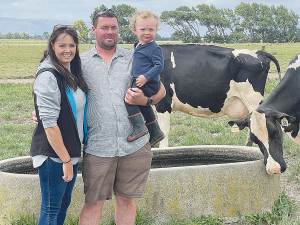Ollie, 2, completes the picture of a driven, yet family-oriented couple who are fully focused on achieving their goals.
Ron, born in Taranaki, and Manawatū-born Amy work together but apart in their wider farming business.
Amy has been contract milking on Grant and Nicky Kearins’ farm for 14 seasons, milking 450 cows. The Bakers purchased their own farm four seasons ago, with Ron taking responsibility for the home farm.
There he milks 160 cows year-round: 60 purebred Holstein Friesians, 15 Ayrshires, and a couple of Jerseys, with the balance commercially-bred crossbred Holstein Friesians. The herd averages 670-680 kgMS/cow.
The herd split calves, with AI for four weeks in the spring, and six weeks in the autumn; the herd undertakes no natural mating whatsoever.
The couple keeps around 15% of total calves as replacements.
Ron says they have always had Holstein Friesian cattle, and when they took over the farm they ended up with a few more.
“We like the fact that the gene pool of the Holstein Friesian breed is so much bigger to breed from,” Ron says.
“There is always a bull out there to correctively mate a cow to.”
He says they have been more milk-driven in their breeding decisions in recent years.
“Milk components are our current priority when choosing bulls, whilst continuing to protect udders, feet and legs.”
Last autumn they used a young Semex bull called Claynook Barolo.
“He is a really balanced bull, both in terms of type and production,” Ron says. “He is a new bull, and we hope to get ahead of the game. We already love the calves coming through.”
Other standout cows in the herd include three impressive cows sired by Gillette Windbrook.
“They are prize producing cows,” Ron says.
The herd’s Dundee Lilly family is also a favourite in terms of high-producing cows.
Te Awhata Dundee Lilly EX, born 2010 and sired by Regancrest Dundee-ET and whose dam is Te Awhata Mike Lill, has had several outstanding daughters.
Larkspur Beemer Libby-ET VG87, born 2017, in particular has proven to be a very successful cow in recent years.
Sired by Pol Butte MC Beemer-ET, she was the 2019 Holstein Friesian and All Breeds Reserve North Island Champion Cow, winning the two-year-old in-milk class, best udder in her age group, and placing second in the All Breeds Two-year-old In-Milk class.
In 2021 she was the NZDE Holstein Friesian Intermediate Champion Cow and NZDE All Breeds In-Milk Intermediate Champion, and also the 2021 Semex New Zealand Comestar Leader – Three-Year-Old Cow New Zealand Champion.
Her sister, Larkspur Windbrook Lil-ET EX, won Intermediate All Breeds Champion at the 2019 Stratford Show.
Libby was first in the 2020/21 HFNZ Production Results Top Cows for Protein and Fat by Ward and Age (Ward 5, three-year-old) with 422kg protein and 449kg fat (12,018L milk).
Showcase Success
The Bakers attended the 2022 New Zealand Dairy Event and enjoyed success with another up-and-coming heifer, Larkspur Lauthority Whip.
Whip, a Comestar Lauthority daughter, won 2022 NZ Dairy Event All Breeds Junior Champion, 2022 NZ Dairy Event Junior Holstein Friesian Champion, All Breeds Junior Yearling Heifer, 2022 NZ Dairy Event Junior Youth Show Reserve Champion, Holstein Friesian Junior Yearling Heifer, and 2022 North Island Junior Holstein Friesian Champion.
Whip, who was exhibited by Lara Honeyfield, is the grand-daughter of the top-producing cow in the couple’s herd, Rewa GW Final Wish EX2. This season, at nine-years-old, Wish produced 1,114 kgMS (14,761L) in a 305-day lactation, a herd record for the Bakers.
“She was our first cow to crack 1,000kgMS,” Ron says.
Fusion Beemer Delish was also exhibited at the 2022 NZDE, coming away with first in the Youth Show Intermediate/ Senior Heifer Calf Class; third in the All Breeds Senior Heifer Calf Class; and third in the Holstein Friesian Senior Heifer Calf Class. Delish was also exhibited by Lara Honeyfield.
It was a proud moment for the couple, who have had to step back from showing as much as they used to.
“Before we bought the farm, we used to take cows to the Waikato and Taranaki Shows,” Ron says.
“But since we have taken on the other farm, we just don’t have time to get away as much as we’d like to.
“Ollie loves the farming lifestyle, so hopefully when he’s a little bit older we’ll be able to take him along with us.”
Fusion Genetics is also enjoying more general farm business successes: the Bakers won the Ward 5 2021 Nutritech Performance Award, achieving the highest dollar earning herd average in their region, based on the Fonterra A+B-C payment for the 2019/20 season, with $4,530.54.
They were also second in the 2020/21 HFNZ Production Results Protein Herd Averages by Ward (Ward 5) with 289kg protein at 3.5%, and sixth in Fat Herd Averages by Ward (Ward 5) with 325kg fat at 3.9% (8,232L milk).











